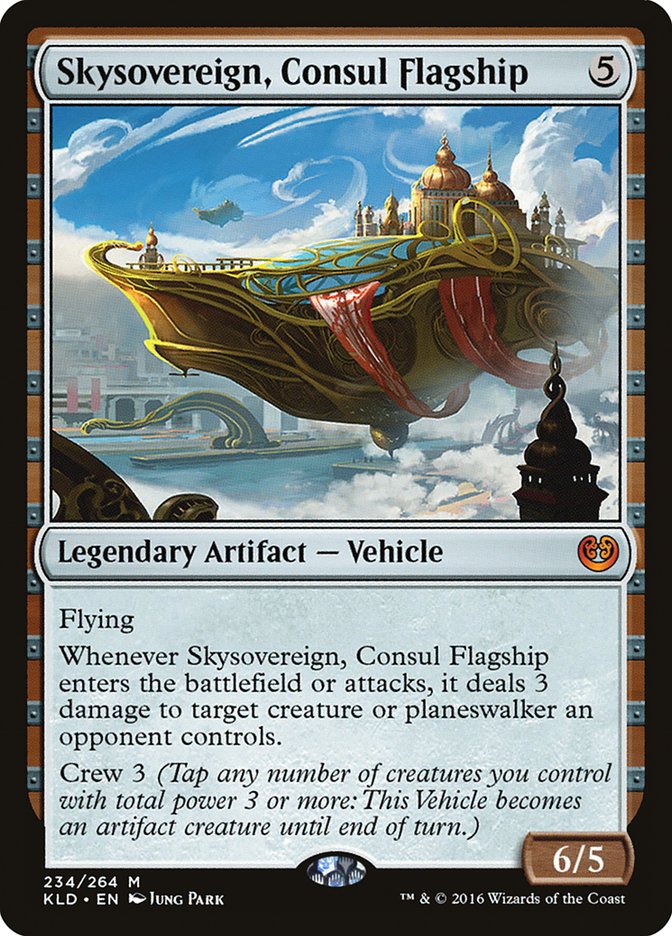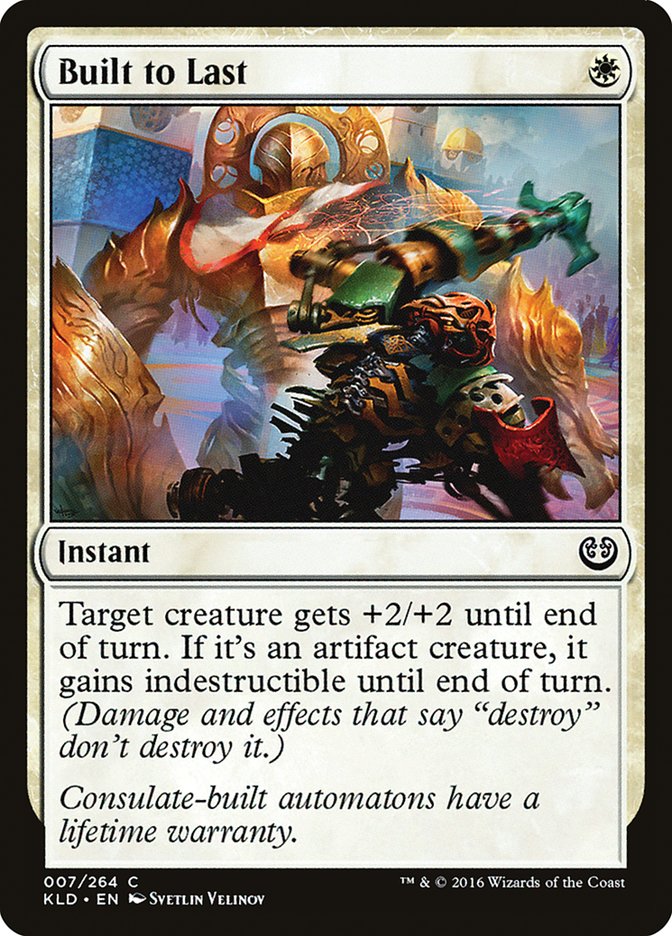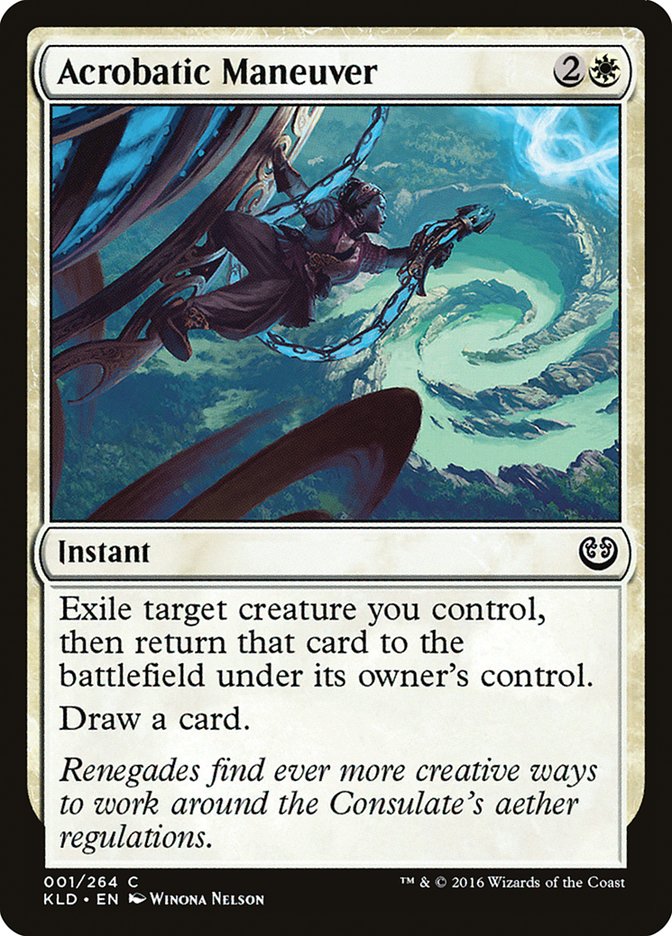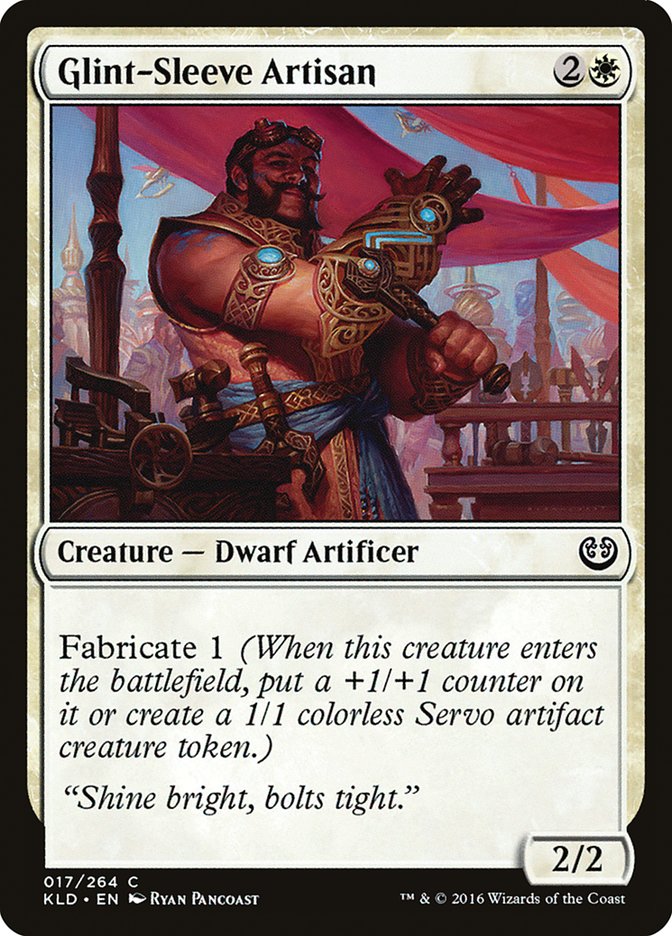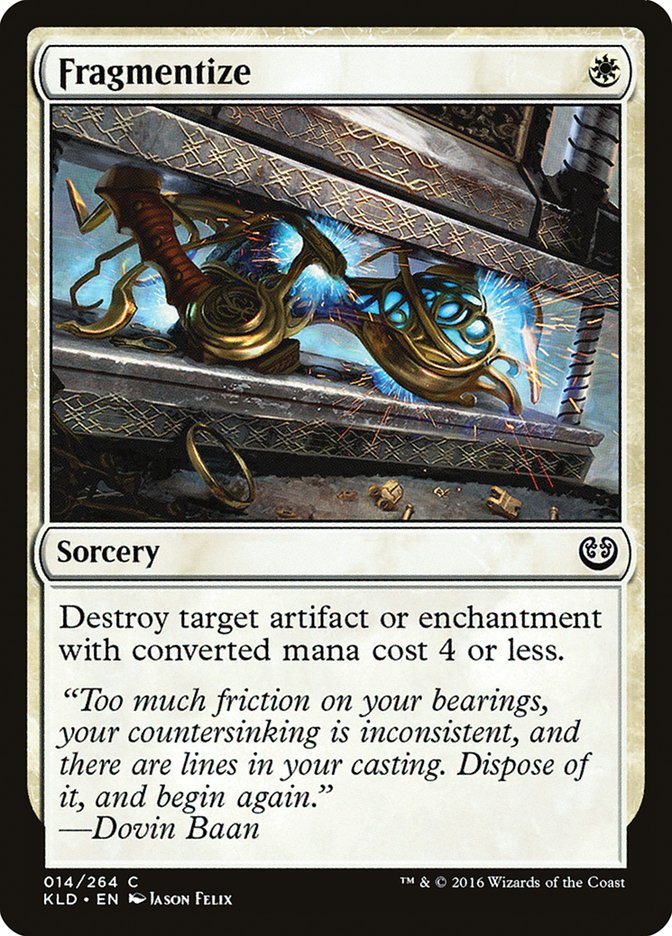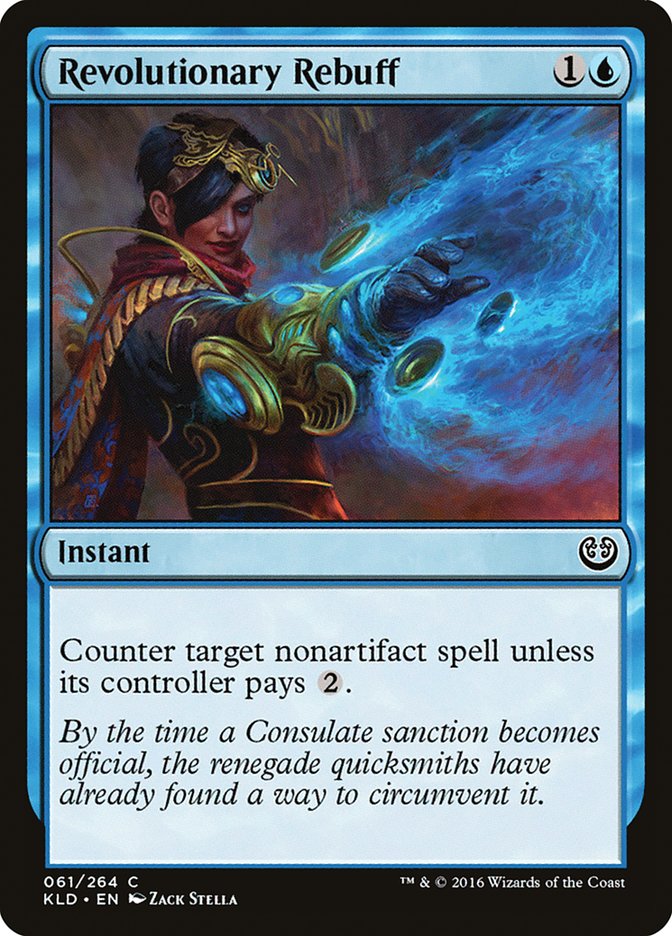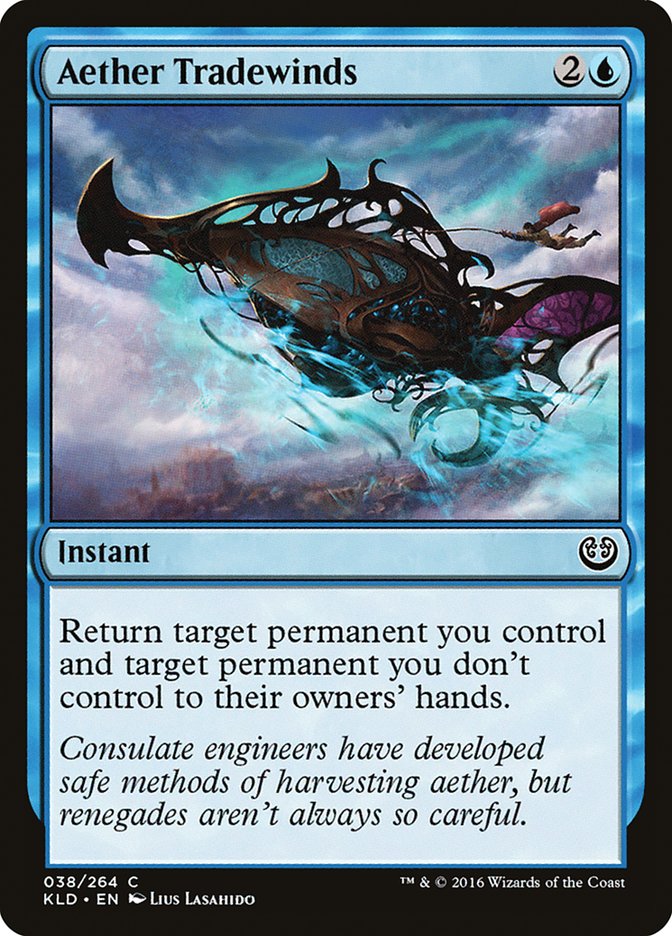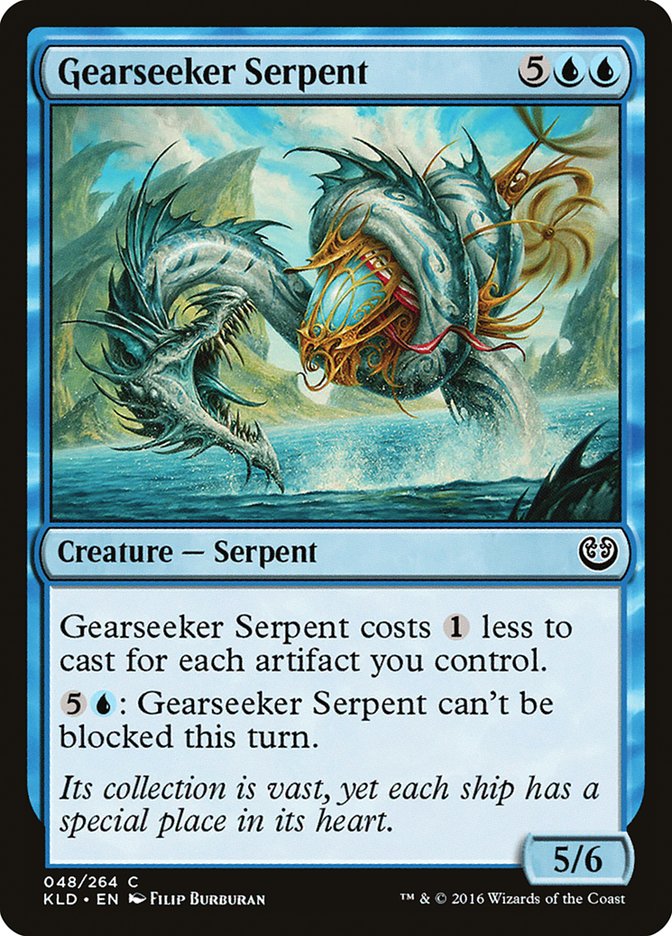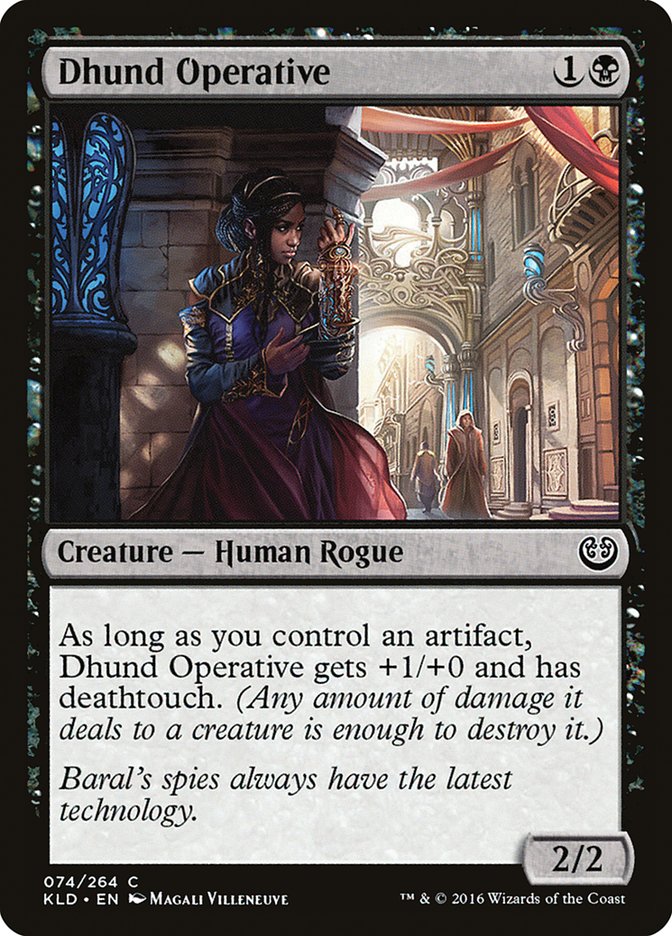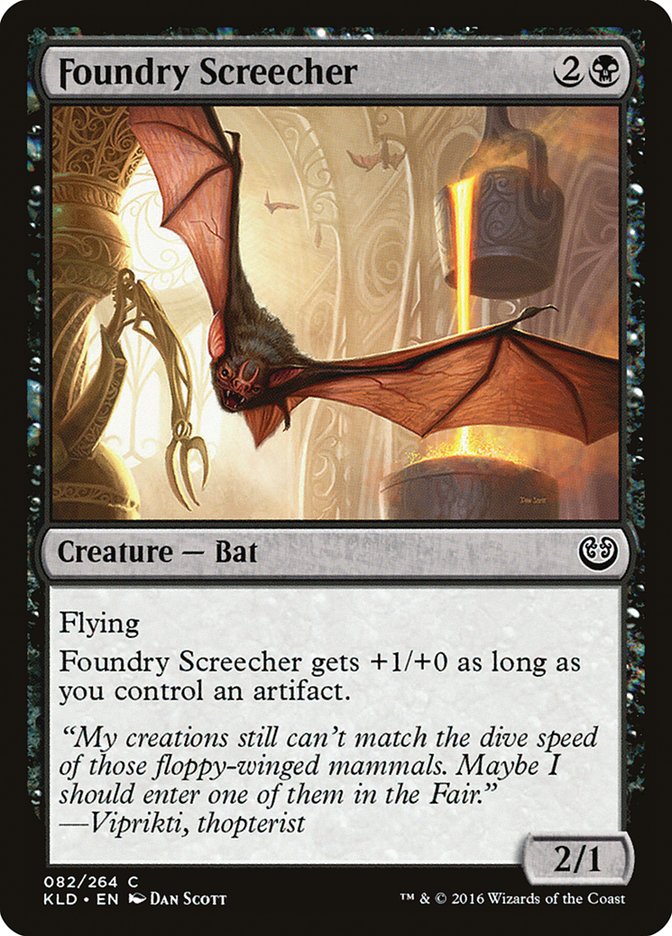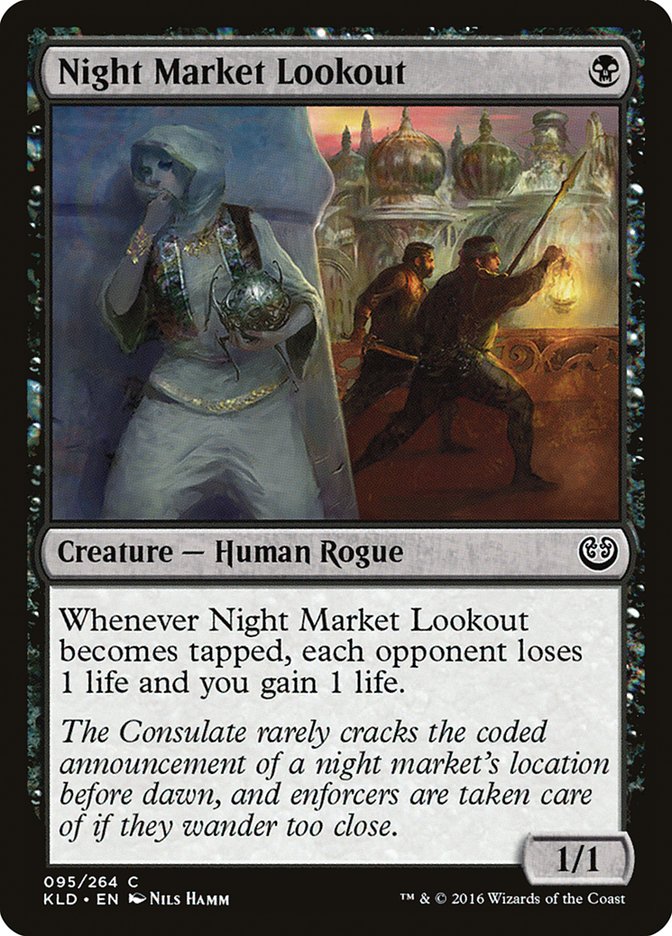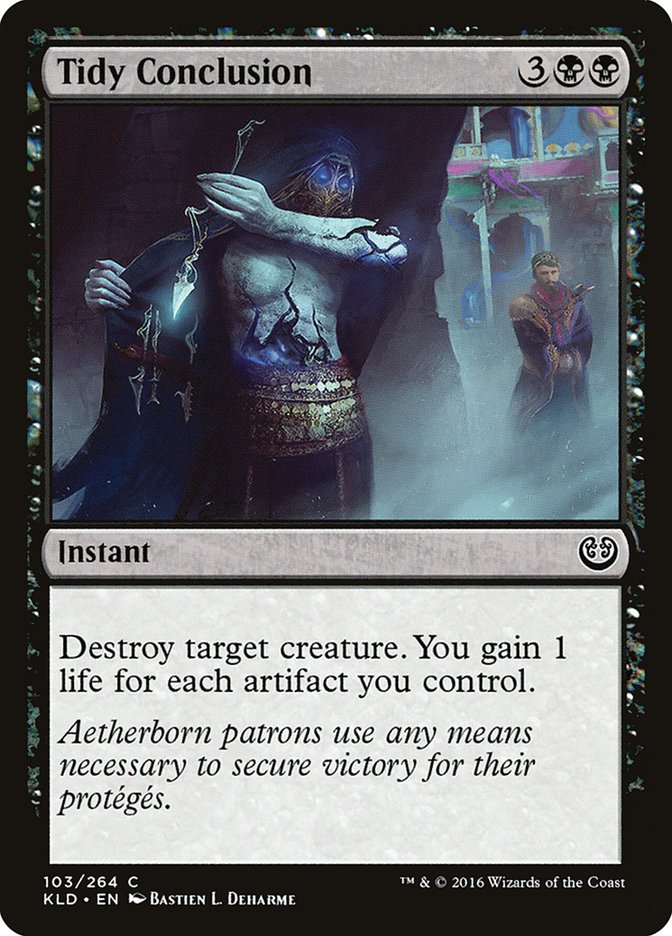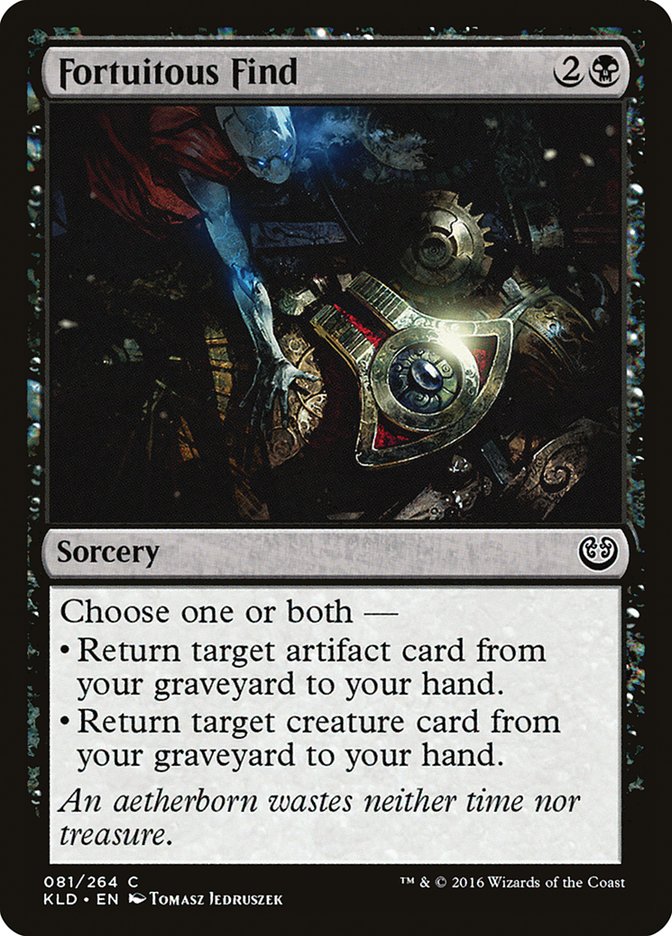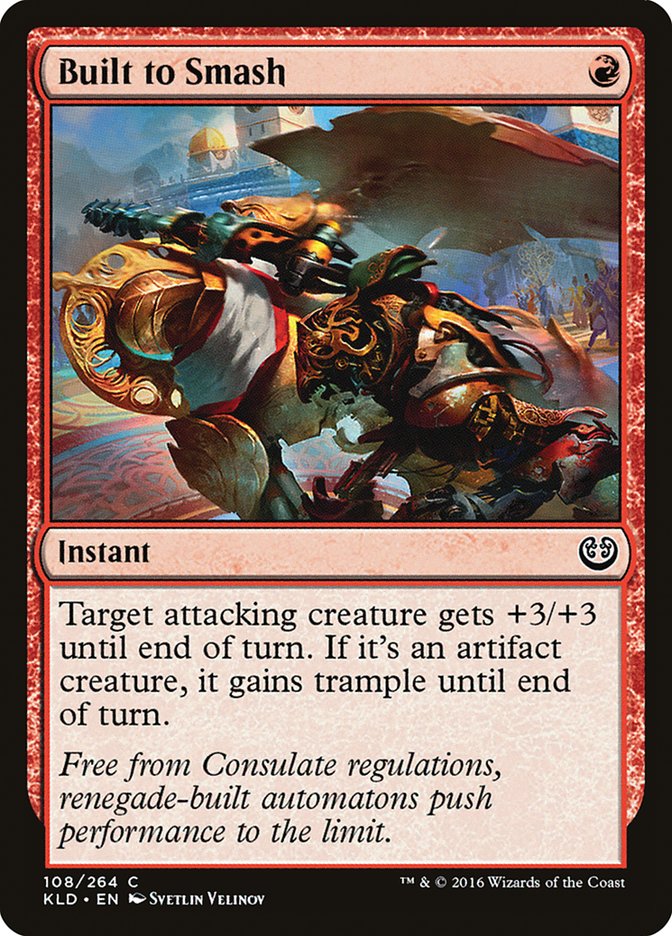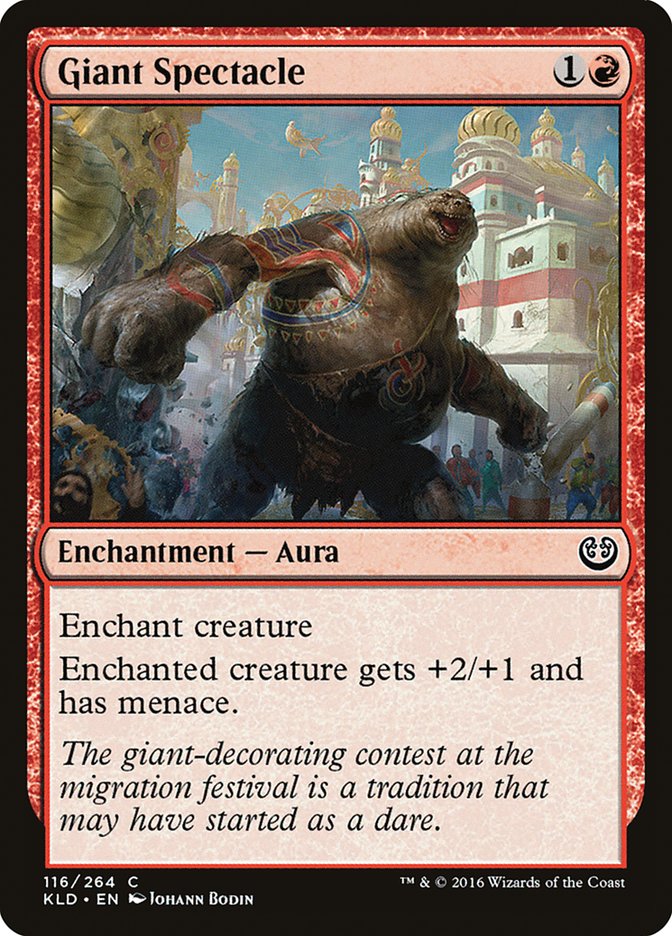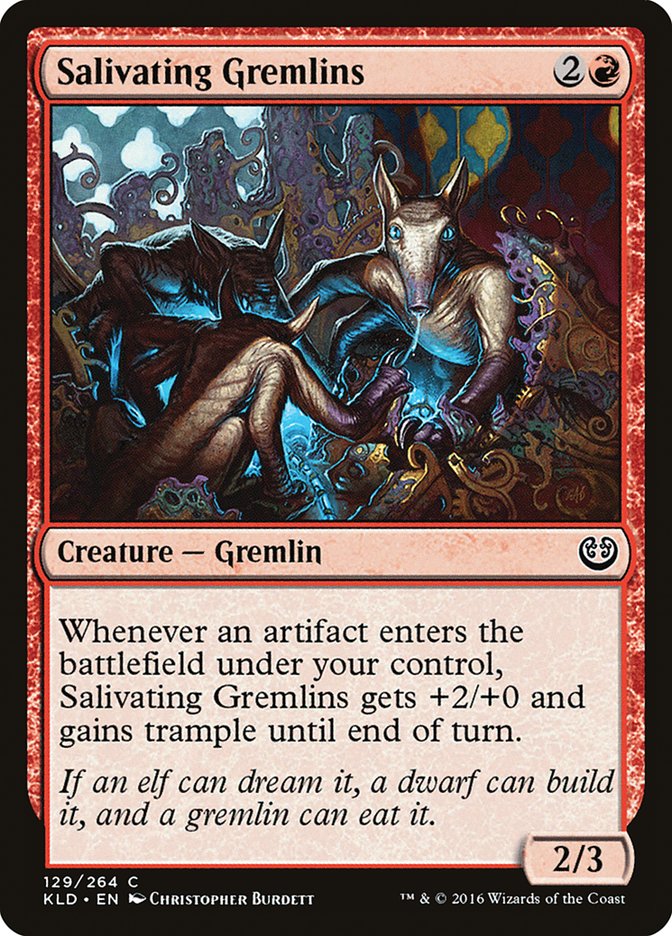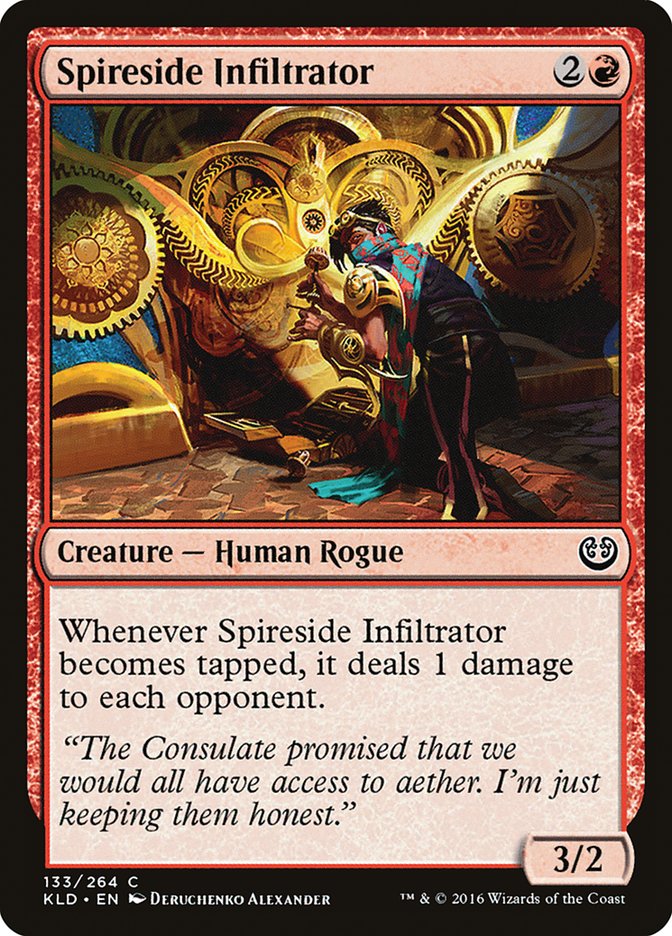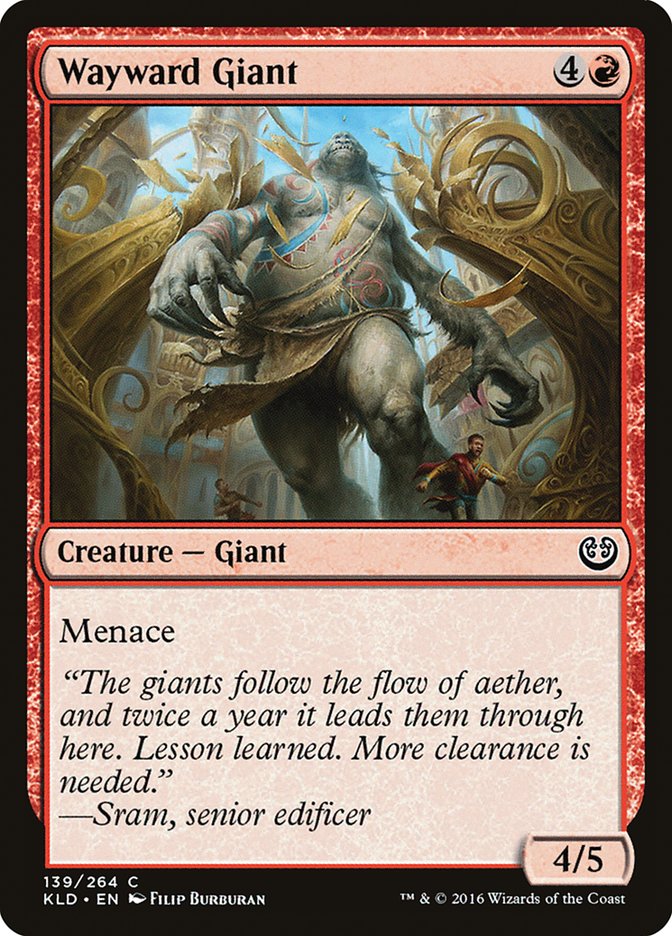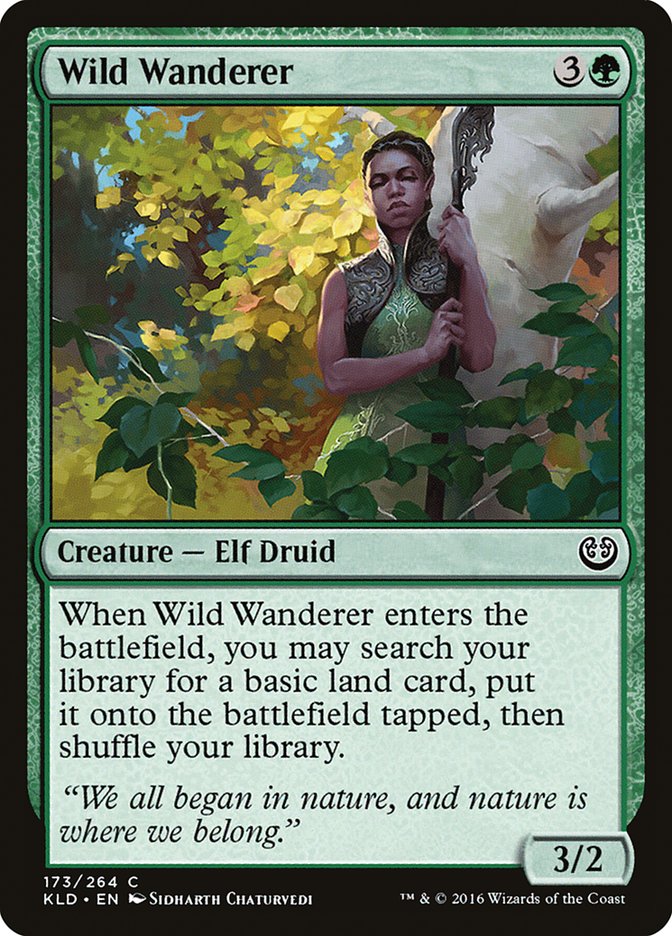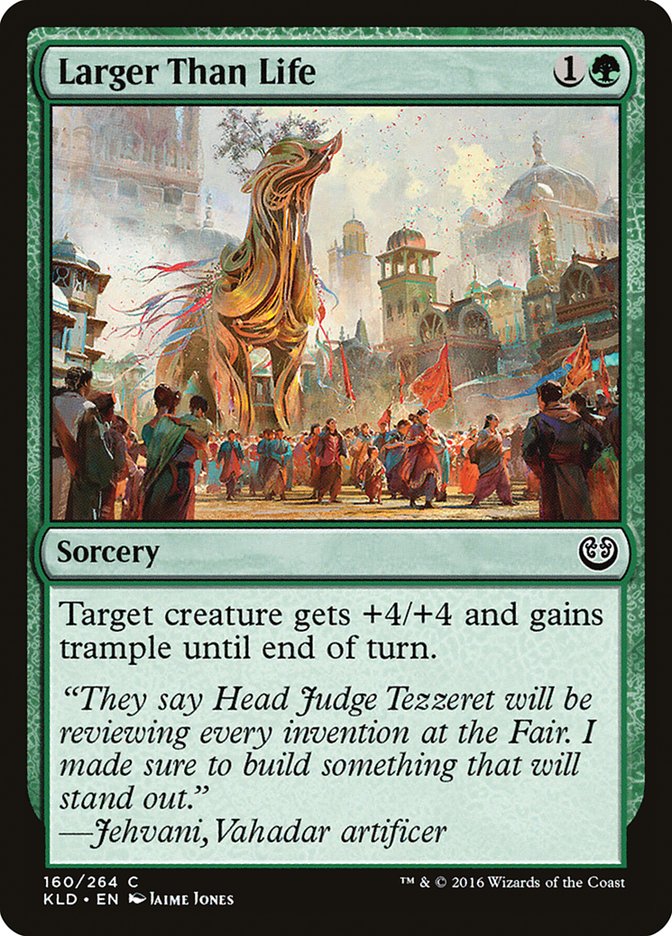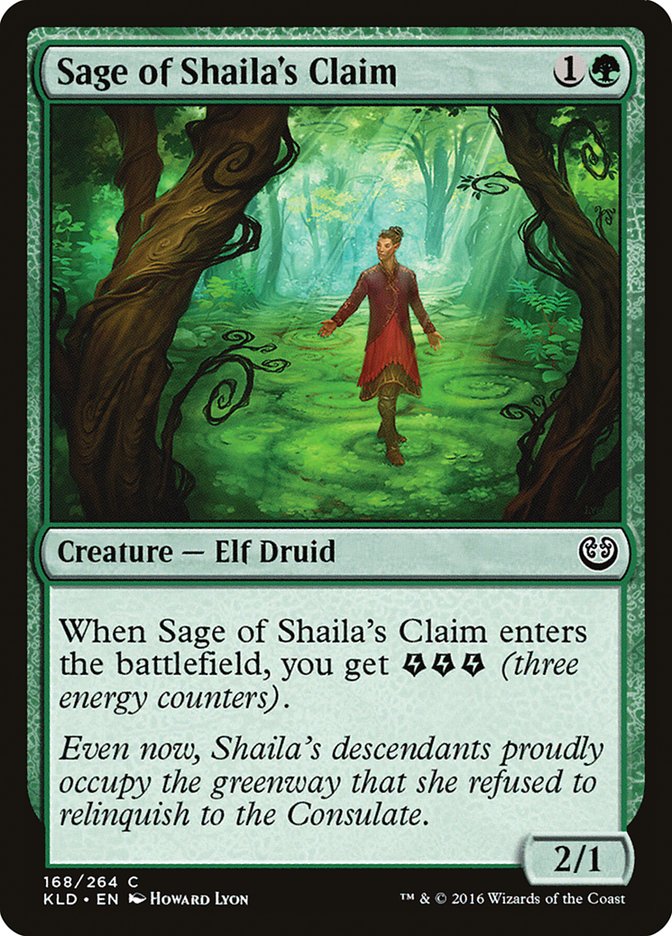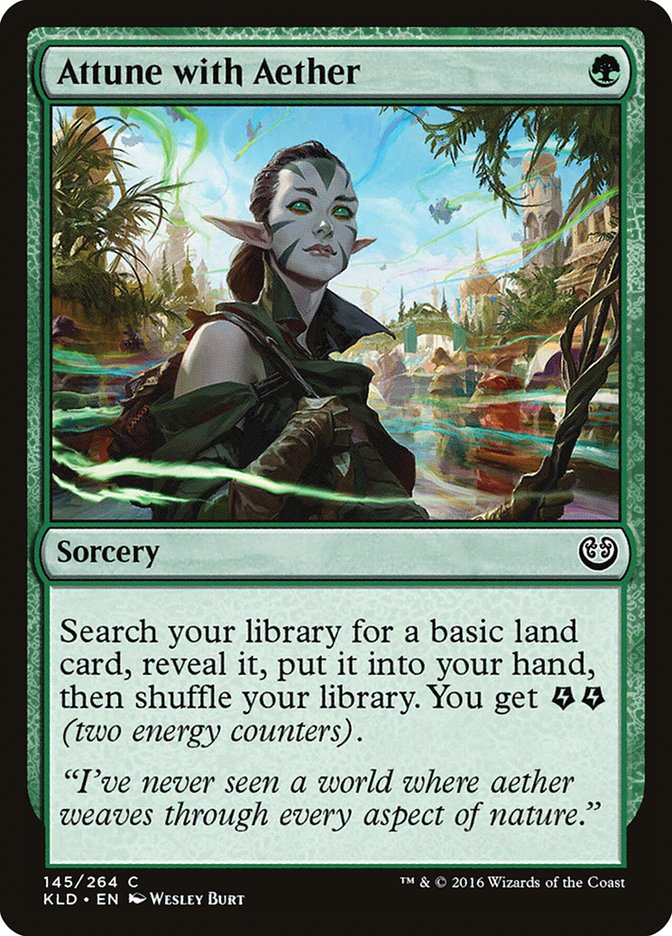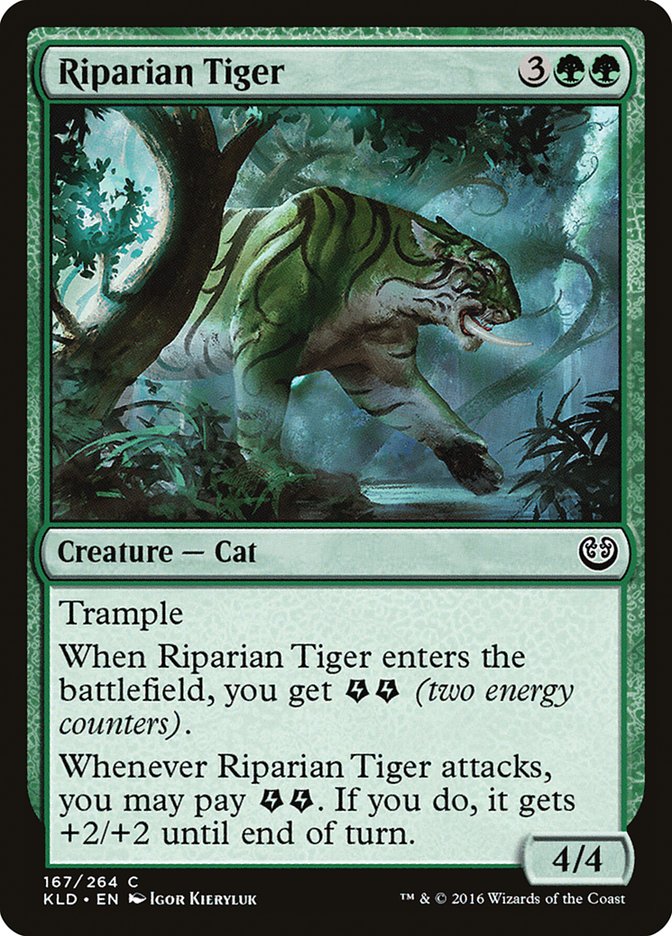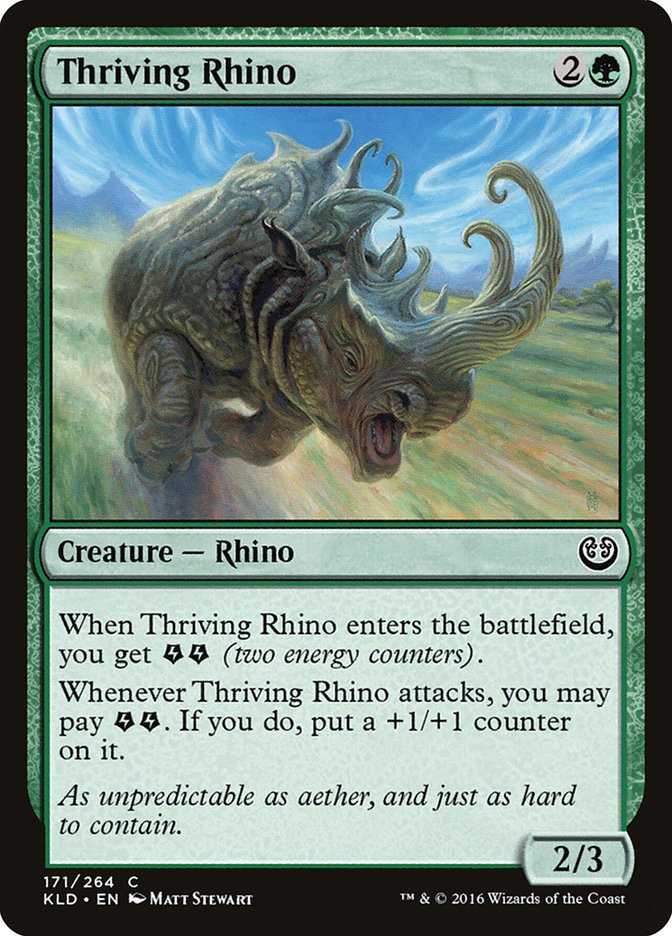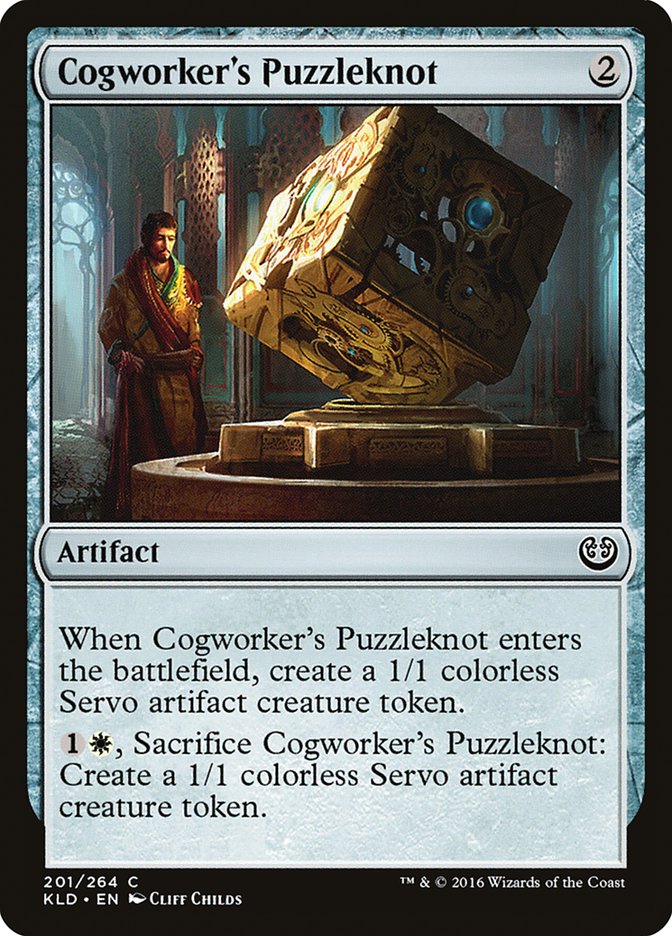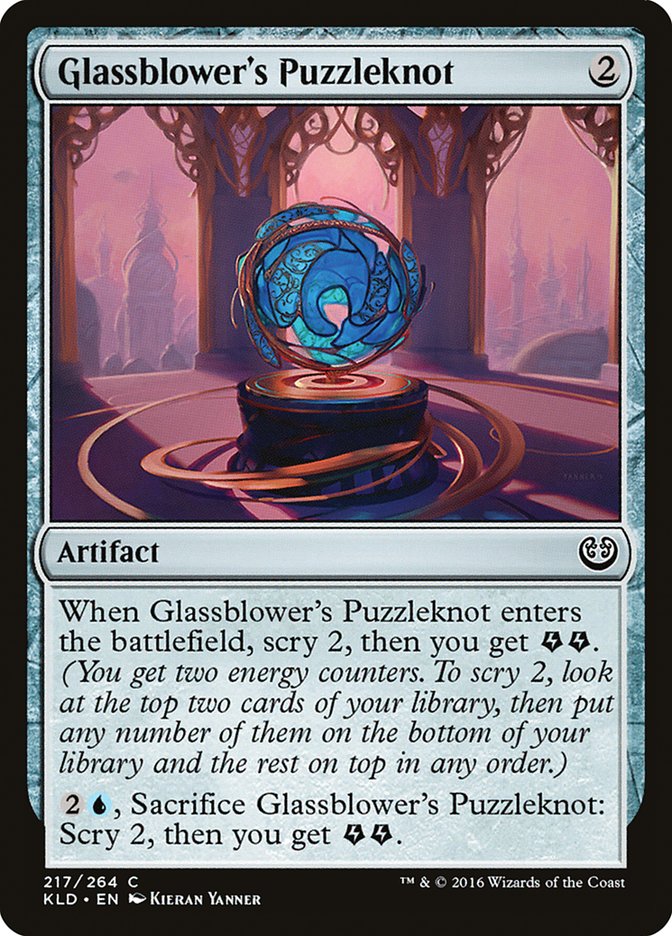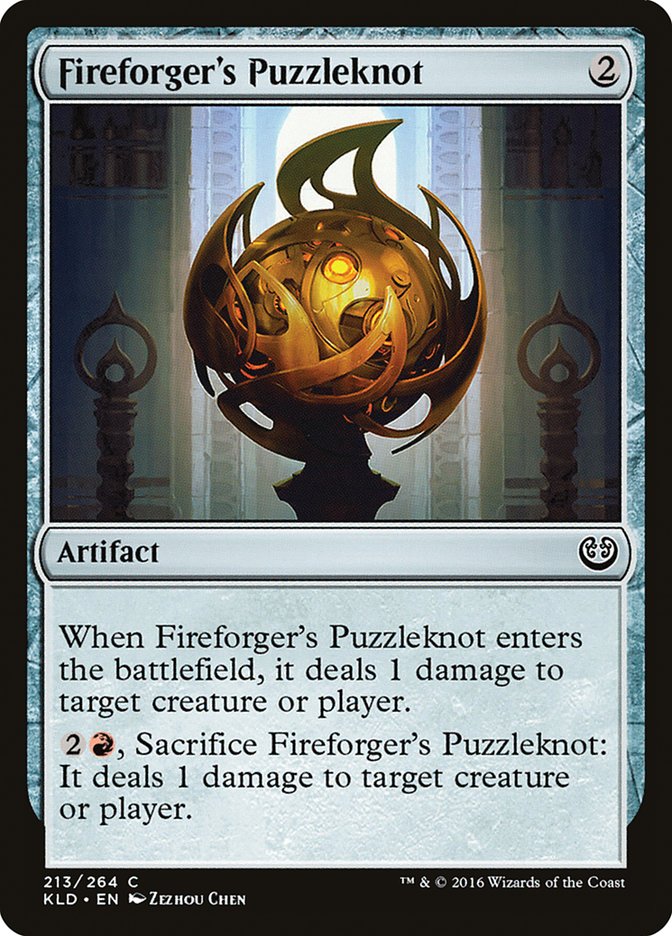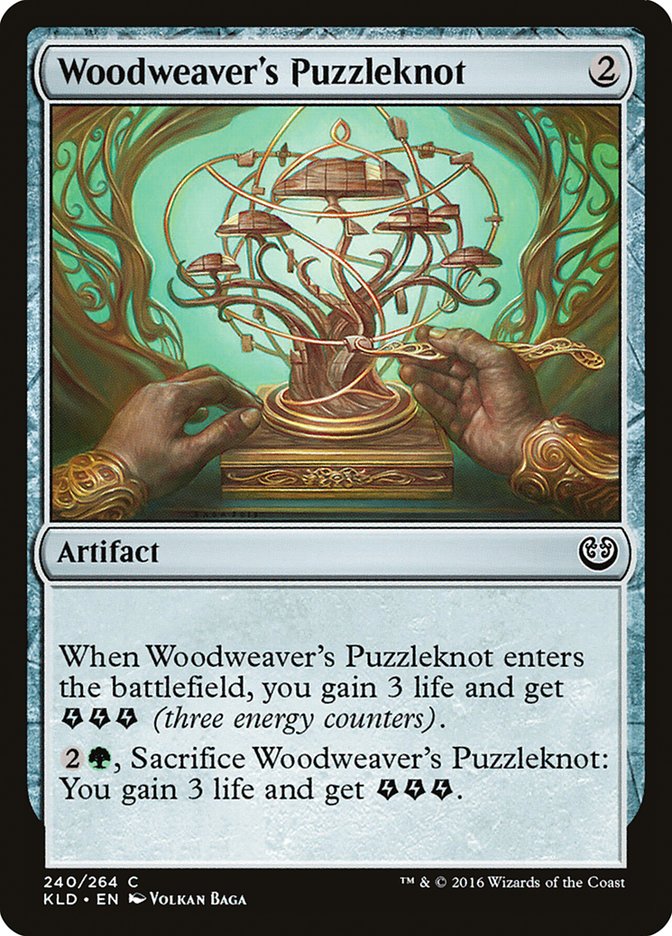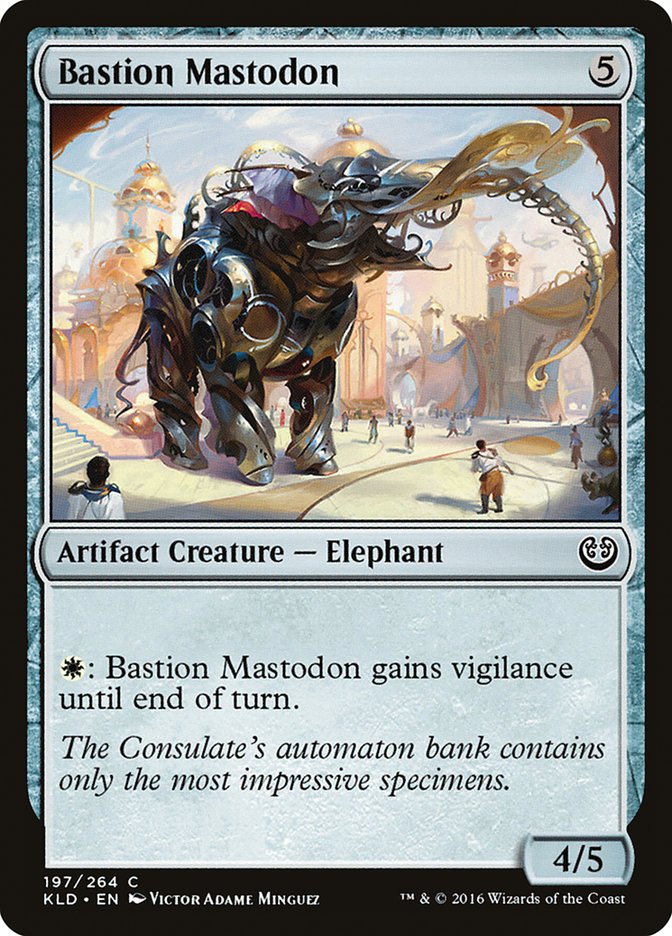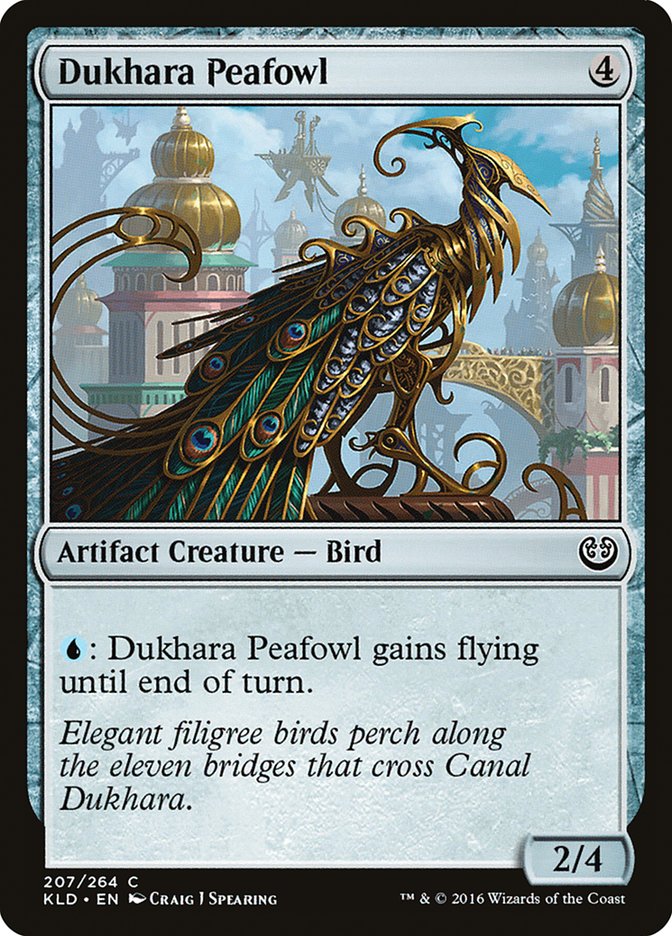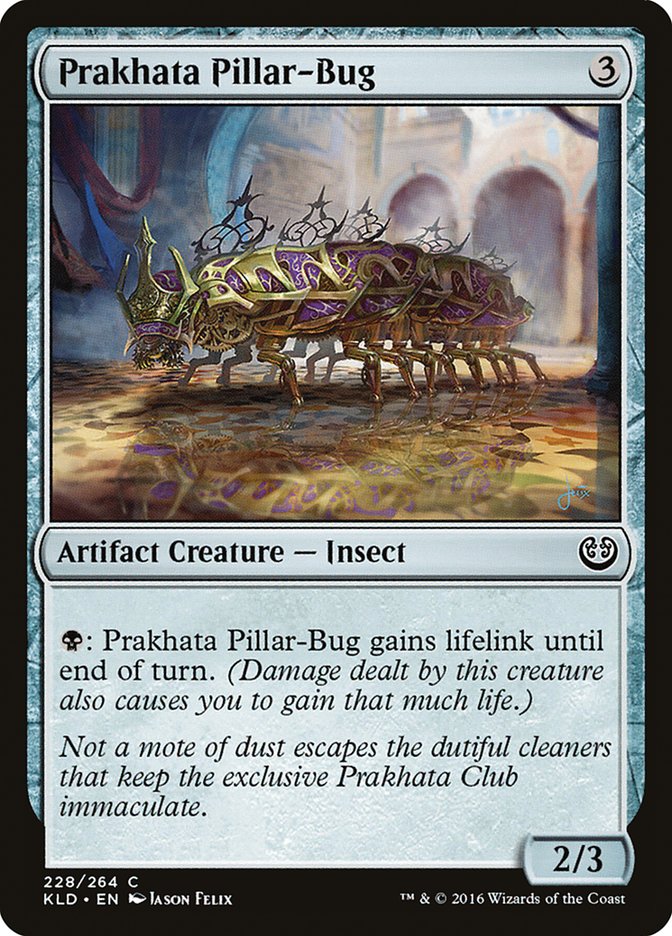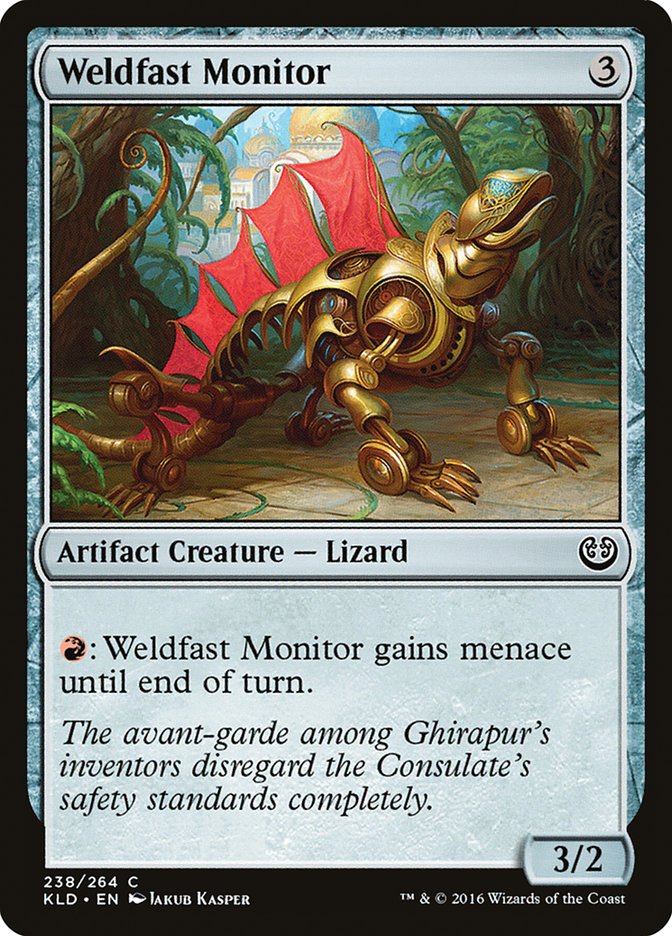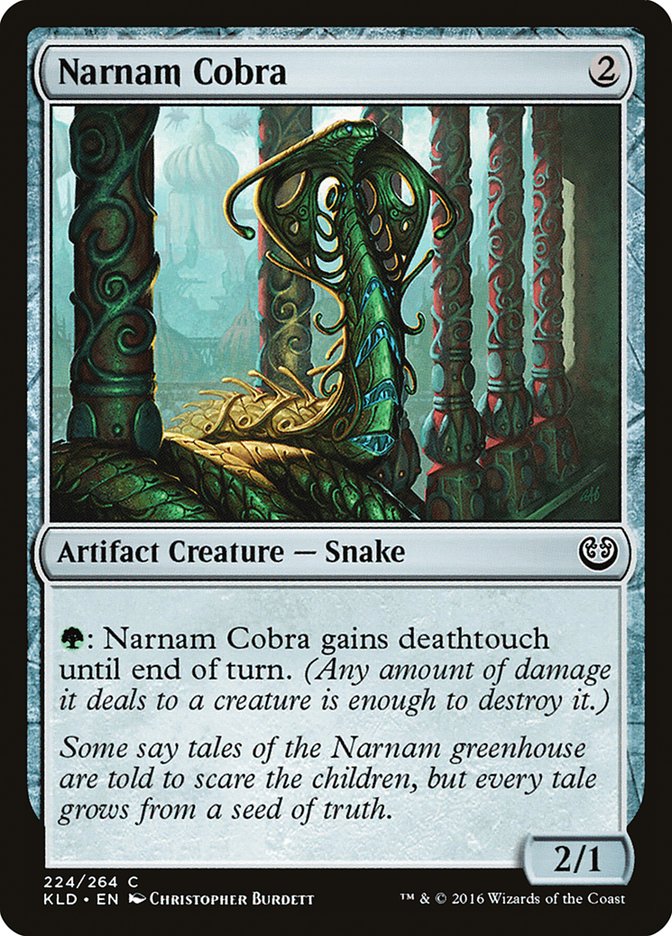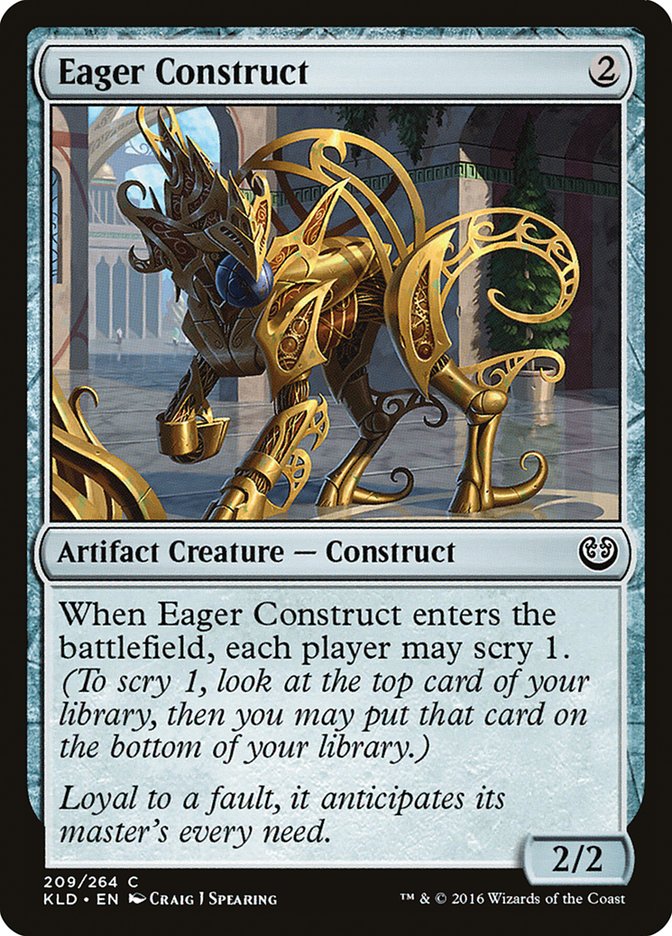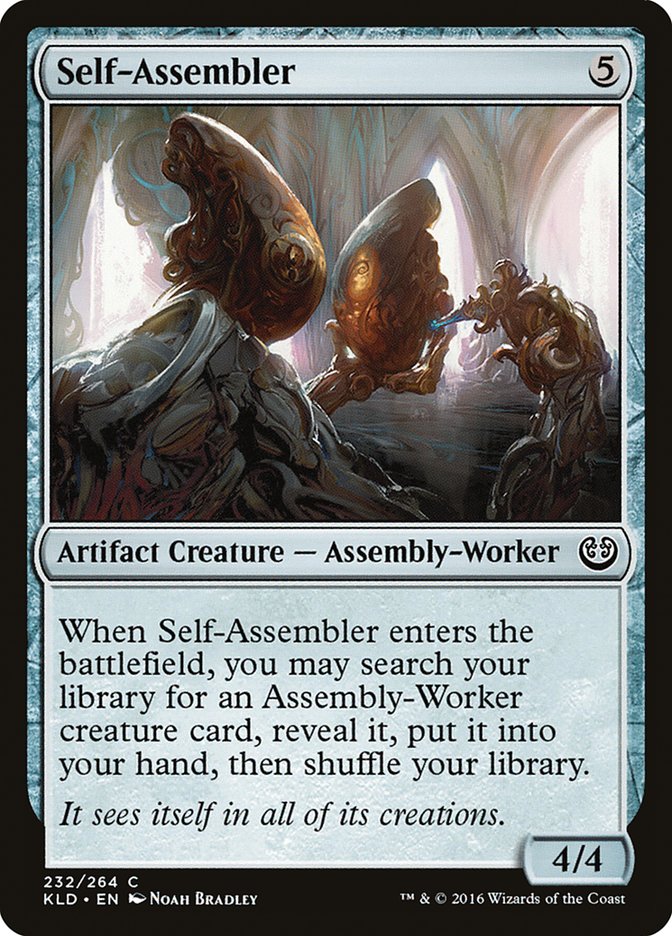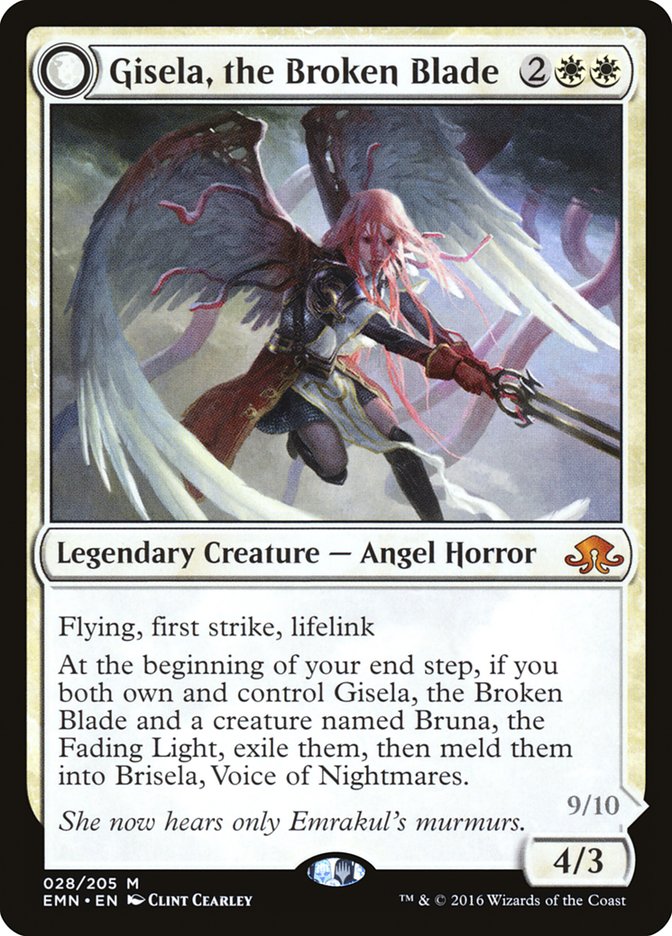Limited is my favorite way to play Magic. There’s just something fun and exciting about sitting down for some Magic and have no idea what you’ll actually end up playing. Maybe it’s the brewer in me, or my laziness, that likes to have my deck build itself for me with the cards I pick up.
Kaladesh is already looking fantastic; I imagine it will be a truly fun format to play. Vehicles provide another dimension of gameplay and hilarity. Who wouldn’t want to drive Skysovereign, Consul Flagship with an army of Thriving Grubs or Crewing a Renegade Freighter with the artificial peacock, Dukhara Peafowl?
The artifact-matters plan is a familiar one for veterans of Mirrodin and Scars of Mirrodin, but Energy is all-new. This extra resource should spice up even a fairly straightforward deck, giving it another dimension. All in all, I’m this set is looking super-fun.
While people like to talk about the splashy mythics, build-around-me rares, and updated manabases, the Prerelease and subsequent Drafts and Sealed PPTQs have to do with the bulk of the cards in the set, the commons. While your normal Standard deck may literally be sixty rare or mythic cards, you’ll be stuck with no more than a handful this weekend. So let’s look at the commons from this set, why they matter, as well as some context in which to consider them.
Whether this is your first Sealed event or your 101st, it’s important to take note of those humblest of spells.
White
White has always had great combat tricks, and keeping your eyes peeled for them is an important part of Sealed, where every combat and interaction chips away at your limited resources. Built to Last is easy to sneak in, costing just one mana, so keep an eye out if your opponent makes a suspicious attack with just a Plains up. Impeccable Timing is no Gideon’s Reproach, but you play what you’ve got.
Acrobatic Maneuver is less a combat trick than a way to protect a good creature or rebuy an enters-the-battlefield effect. Cloudshift was a strong choice in Avacyn Restored, and this level of flexibility is important. Keep in mind, though, that three mana is a lot for a conditional effect, so not every deck wants something like that.
Glint-Sleeve Artisan represents the baseline card for the Fabricate mechanic and perhaps one of the more powerful common creatures in Kaladesh. As a 3/3, it’s great at applying pressure against 2/3 defenders or attackers, and as a 2/2 with a 1/1 Servo, this creature can split its power. While it’s nice to have multiple creatures to spread across power, this is particularly relevant with Vehicles; excess Crew numbers are wasted, so if you can maximize your utilization, you have more flexibility.
Ninth Bridge Patrol is, in many ways, a better Unruly Mob, and I know more than one of you has faced down a 7/7 Unruly Mob. This card, while innocuous on its own, can grow quickly, assuming the support is there for it. Again, not every deck wants it, which is something I really like about this set.
Fragmentize can target all but one of the set’s twelve enchantments, three of which are at common, and 43 of the set’s 56 artifacts, so this card will have no shortage of targets. I still might keep it in the sideboard, as I believe its primary upside, killing creatures, is limited on the number of artifact creatures they actually play. If you’re just using it as a sorcery-speed Natural State, I’m less impressed. In other words, it’s not an auto-include unless you need the filler.
Blue
Blue is traditionally a color of spells and high-toughness critters, and Kaladesh is no exception.
Kaladesh has dedicated a quarter of its blue commons to bouncing and counterspells. None of the counterspells particularly excite me for Sealed unless they have a must-counter threat, but the bounce spells are great. Select for Inspection is a prime instant to defend oneself from attack. Block with your defenders and let them try a combat trick to overrun them. Then you erase the trick, protect your team, and scry 1. It’s not Vapor Snag, but it’s a surprisingly solid defensive trick, and it can bounce a Crewed Vehicle or the Crew. Aether Tradewinds, a reprint from Worldwake, brings a true Boomerang effect back. You can bounce any permanent with this, including lands, which makes it so you always have something to bounce, while you can hit their most critical target.
Blue’s strongest common creature gives a solid payoff for running artifacts. For Gearseeker Serpent to reliably come down at a better-than-average rate, you’re going to need at least five or six artifacts in your deck, but it is still playable without that many. Its ability to end the game in a hurry should not be underestimated, and remember, this isn’t a typical Serpent; it can always attack, unlike some of its predecessors like Floodtide Serpent or Deep-Sea Terror. I could see a successful, defensive Sealed deck with ten artifacts and three of these doing just fine on Saturday.
Black
These are all great rates at common, and they all benefit from artifacts. Dhund Operative is an exceptionally dangerous Grizzly Bears with an undeniable presence on the battlefield thanks to its easily met condition. Similarly, Foundry Screecher is a card we’ve played before in the form of Kelinore Bat, except with an upside. A 3/1 flyer for three mana is right where lots of decks want to be; no matter what Sealed format you’re in, flying is relevant. For a one-drop, Night Market Lookout is admittedly conditional, but it’s great for Crewing many of the common Vehicles, and the life loss can become relevant as your opponent stabilizes. Remember, if you have mana up for combat tricks, it’s often a free attack, as you’re already incentivized to do so, masking your ruse.
Subtle Strike can do a lot; sure, it can pick off a Servo creature token or an errant X/1, but it also can be used in combat. A careful mage can create a two-for-one, shrinking a blocker and growing another attacker, killing two creatures and giving one of yours a permanent boost. Tidy Conclusion’s cost would have made Magic players from 2009 laugh, but we’ve gotten used to five-mana unconditional removal at common. Rest assured, this is very playable, even if you don’t have any metal in your Sealed deck. Fortuitous Find is either the best card in your deck or the worst, depending on the overall power level of your deck. Getting back a Wind Drake and a Metalspinner’s Puzzleknot isn’t exactly groundbreaking, but getting back a Noxious Gearhulk and a Gonti, Lord of Luxury is probably an auto-win.
Red
Man, I love when red is all about getting sideways.
The parallel with Built to Last aside, Built to Smash can hit really hard. Nine times out of ten, you cast Brute Force on an attacking creature, and now you even get a bonus if you crash with Vehicles; the trample is really important, considering the sizing of even the most common Vehicles. Giant Spectacle looks an awful lot like Madcap Skills, one of the best Common auras printed in recent history, so play this with extreme prejudice. Hijack? Well, Act of Treason has always been good in small doses; while harder to splash, this is considerably better than its predecessor, especially at common.
Red’s creatures are the same way.
Notice how none of these creatures have vanilla abilities related to blocking? Take the hint! Red has plenty of combat tricks to support that plan, so there’s
Green
Green is actually a bit different this time around, at least from the perspective of commons. None of their cards care particularly about artifacts. They’re mostly about doing the things that green does best: ramp and make big creatures.
Wild Wanderer is a problem-solver. Got a Gearhulk but have to work your manabase hard to splash the color? Wild Wanderer. Need a reasonable blocker while you develop your manabase to two spells a turn? Wild Wanderer! Unlike cards in the past like Wood Elves, this card has a fair sizing for its ability; at the end of the day, a creature with an enters-the-battlefield ability is only good if it can fight reasonably at curve.
Peema Outrider is solid enough as a 4/4 trampler, and in many cases, I think you might take that over a 3/3 and a 1/1. This set has plenty of ways to pay off for your tramplers, so keeping it big is probably best. Larger Than Life, while not really a combat trick, grants trample and a power boost at what has become a decent rate. I wish this had an Elemental Uprising effect where a creature had to block it, but if you’re coming at them with a 9/9, they’ll probably be blocking anyway.
What many green cards do care about is Energy.
Every other color gets two common Energy producers, but green gets four, taking up a considerable portion of their real estate. This means that one of the biggest reason to go green is for the Energy producers and payoffs instead of its creature sizing and fixing ability that it’d otherwise be famous for. With a sufficient infusion of artifacts that care about energy, green’s tenuous friendship with Magic’s sixth “color” can become quite companionate.
Speaking of artifacts…
Artifacts
There are half again as many colorless artifacts as there are monocolored cards, so the theme in this set is clear. The ratio of commons is also comparable to each color, so there’s lots to explore here at Magic’s lowest rarity level.
The Puzzleknot cycle feels much like the Cluestone cycle from Dragon’s Maze did, except this has a relevant card type. At least in Sealed, I imagine most decks will play as many of these in their colors as they have, providing a relevant turn 2 play, a lingering presence as an artifact, and then a final cash-in identical to the first. Out of the five, Glassblower’s Puzzleknot, Metalspinner’s Puzzleknot, and Woodweaver’s Puzzleknot have the most potential, and the black Puzzleknot requires the least additional commitment.
Each of these creatures has its place, but I think the best one is either the Bastion Mastodon or Prakhara Pillar-Bug. Vigilance on a well-costed body is great, and Bastion Mastodon is playable as curve filler in any color, while Prakhara gives black a reasonable lifelinker at common. Lifelink is increasingly rare at common, so having access to a three-toughness blocker that gains you life each turn is pretty decent.
Eight commons remain, two of which are of particular note.
Notice something about Eager Construct? It’s a 2/2 for two with at least a somewhat shared upside, much like Runed Servitor. In fact, look at all of the common artifact creatures. All of them are reasonably costed vanilla creatures that are playable in any color. Blue gets a 4/5. Red gets a 2/4. At least for Kaladesh, the common practice of lowering a creature’s power based on its flexibility as an artifact has been removed. They’re all respectable now.
Self-Assembler is likely the only build-around common artifact in the set, and even then you’re stretching a bit. Generating an endless stream of Bonebreaker Giants is not too game-breaking, but it is inevitable. I could see a Draft deck pulling five or six of these and just adding threat after threat, turn after turn. I’m sure there’s even a way to work with this creature in Standard, but until then, I’ll hope we see some other Assembly-Workers this time around.
There you have it, the commons of note for Kaladesh. This might not be the most gripping article you’ve ever read, but the more you can recognize these cards and remember them, the better you’ll do in an event with card pools that are roughly 71% commons. Take these into battle, form your strategy, then win on the back of the set’s many outstanding commons!
Comments from Last Week
Last week, I took a crack at two decks surrounding Aetherflux Reservoir, one based around Grixis’s ability to draw and discard large quantities of cards and the other an Abzan deck that actively gained life to get to the 50-life cutoff. Our community had some great advice about my two initial builds.
“May I ask why you only use one copy of the artifact when they can stack and give you more life?” – Garrett Avila
You sure can, Garrett. Unfortunately, we play in a world where our opponent is trying to kill us. Spending four mana to have little to no impact on the battlefield is a dangerous gamble, and the rest of the deck has to make up for this. The Abzan list featured only one copy because there were many ways to get it (or recover it if discarded or destroyed), and the lifegain was assisted by cards that gained life incidentally. This is just a card parity rule; two are often worthless without lots and lots of draw (which is why the Grixis deck has two.)
“Where is Kalitas, Traitor of Ghet in all of this? He would be perfect for this kind of Abzan lifegain deck and fits the role of attacker/blocker well…Gisela, the Broken Blade would here as well as another option.”
– Steven Sheriff
I had a copy of Gisela, the Broken Blade in an earlier draft and just wasn’t pleased with her. Kalitas, Traitor of Ghet is much more of a one-card engine, and is likely a solid choice. He can also eat Zombies he makes to become an even larger lifelinker.
“Nope to all of this. Build storm. You have Bone Saw, Cathar’s Shield and Paradoxical Outcome. That’s plenty.”
– Riley Clotfelter
If you were to do something like this, I’d be concerned that our card quality would be so low that we’d not only be utterly reliant on a multi-card combo, but we’d have no way to win the game outside of it. Our card selection isn’t quite good enough, in my opinion, to fully support an Eggs-like strategy in Standard, though I may just not be seeing the pieces.
However, I was fiddling with a mono-red version of Aetherflux Reservoir that might have some play.
No idea if this is playable yet, but it was appropriately spawned from looking at Spark of Creativity. From there, the deck came together, using the power of Cathartic Reunion and Tormenting Voice together to dig deep into the deck, making Madcap Experiment easy discard fodder or a more likely way to find Aetherflux Reservoir without dying. Chandra, Torch of Defiance and Bedlam Reveler can either keep the party going or end the game themselves if needed.
What hidden gem have you found within Kaladesh’s less highlighted cards? Perhaps some interaction that might be handy to know for his coming weekend? Which part of Kaladesh are you looking forward to the most?


